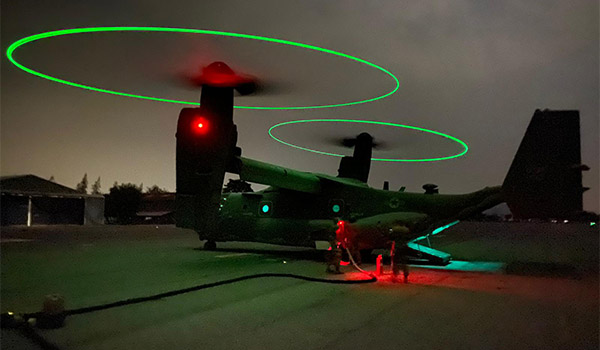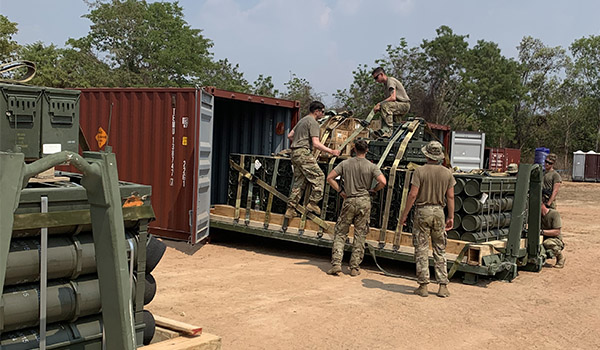
By CPT John Walsh: Since its inception in 2014, the Pacific Pathways program has provided U.S. Army Pacific units the opportunity to deploy and train with partner and allied forces in the Indo-Pacific region. Though no two Pacific Pathways deployments are the same, every rotational unit must address the challenge of operating in a distributed environment. Pacific Pathways is a unique stressor of the sustainment warfighting function. For an Aviation task force, a Pacific Pathways deployment requires the Aviation forward support company to provide fuel, ammunition, and maintenance capabilities to multiple locations separated by hundreds of miles of jungle and ocean.

TF Hammerhead FARP at Lop Buri, Thailand, refuels an Air Force CV-22 / ALL PHOTOS – U.S. ARMY E/3-25 AVN PHOTO
In early 2020, Task Force Hammerhead of the 25th Infantry Division simultaneously operated four forward arming and refueling points (FARP), throughout northern Thailand, enabling an operational range of over 90,000 square-miles: for comparison, the National Training Center at Fort Irwin measures just over 7,000 square miles. In preparation for such a mission, Aviation FSCs must consequently develop training plans that certify squad and section level leaders to execute distributed operations to a greater extent than currently tested at Combat Training Centers. This author’s Aviation FSC was required to deploy at most three FARPs for limited duration at a 2020 Joint Readiness Training Center rotation.
Section Certification
The distributed nature of a Pacific Pathways deployment will demand more of junior leaders in the FSC than an average CTC rotation. In preparation for Task Force Hammerhead’s deployment, the FSC established a section certification program executed in a six-table format. These six tables evaluated petroleum specialist tasks in ATP 4-43, HEMTT and HTARS maintenance, communications equipment operation, and live day and night FARP establishment. The certification program grew into a best section competition and is now executed quarterly.

Each FARP Soldier was ammo handler certified to facilitate Class V management

Cross Training
The Aviation FSC MTOE varies by supported battalion, and the unique considerations of each Pacific Pathways mission will dictate different requirements for every Aviation task force. Due to the complex physical and human geography of the Indo-Pacific region, Aviation FSC commanders must be prepared to deviate from standard MTOEs to tailor support to mission requirements.
A cross-training program that addresses MTOE shortfalls can be implemented to ensure FARP sections are prepared to distribute fuel and ammunition, maintain their equipment, and defend the FARP. In Pacific Pathways 2020, Task Force Hammerhead’s Aviation FSC’s four FARPs required 40 personnel, 16 fuel tankers, and associated maintenance equipment and rolling stock. Each section included maintenance and fuel personnel. Regardless of MOS, each Soldier attended the ammunition handler’s course and fuel handler’s course to ensure that every section was prepared to distribute Class V and to build a bench of auxiliary fuel handlers across MOSs. The FSC headquarters retained a robust maintenance section to serve as a contact team to any FARP requiring maintenance beyond the capacity of the section.
The equipment set and personnel complement for each FARP provided the commander the ability to maintain 24-hour operations when necessary and to establish secondary FARPs in the local area. Task Force Hammerhead was able to operate three secondary FARPs in support of live fire operations in addition to the four main FARPs across Thailand.
Lessons Learned
Conducting a battery of section certification exercises proved instrumental in Task Force Hammerhead’s ability to sustain Aviation operations over an area spanning nearly 90,000 square miles. Not only did each section execute its collective tasks more efficiently, but standardization of FARP procedures across the four sections also made it simple to move qualified individuals to different FARPs in order to allow them to experience different areas of the country.
Certification of the FSC headquarters’ command and control functions should be conducted in conjunction with FARP section certifications. Further improvements can be made across the FSC to standardize reporting timelines, leverage the digital report formats of the JCR-LOG, and incorporate JCR training into a certification program.
The INDOPACOM AOR is one of the most diverse regions on earth. No single MTOE change or doctrinal guideline will ensure the success of an Aviation FSC in a Pacific Pathways rotation. However, an Aviation FSC that is prepared to survive and thrive in a distributed, austere environment will likely thrive in any environment.
CPT John Walsh is the commander of Company E, 3rd Bn., 25th Cbt. Avn. Bde., at Wheeler Army Airfield, HI.








